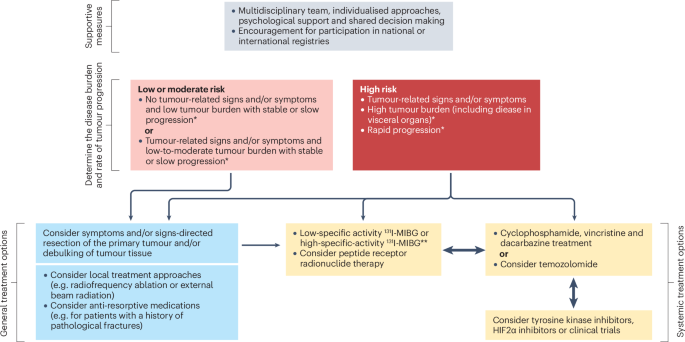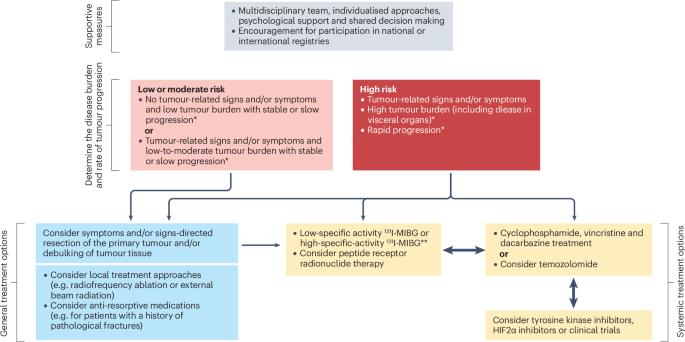关于儿童和青少年嗜铬细胞瘤和副神经节瘤诊断和管理的国际共识声明
IF 31
1区 医学
Q1 ENDOCRINOLOGY & METABOLISM
引用次数: 0
摘要
辉铬细胞瘤和副神经节瘤(PPGL)是一种罕见的神经内分泌肿瘤,不仅发生在成年期,也发生在儿童和青少年时期。多达 70-80% 的儿童 PPGL 具有遗传性,因此儿童患者中转移性和/或多灶性 PPGL 的发病率高于成人患者。与成人患者相比,儿科患者在肿瘤生物学和管理方面存在重大差异,加上罕见疾病的发病率和治疗方面的挑战,因此需要跨学科的专家团队密切合作。团队成员最好包括成人和儿童内分泌专家、肿瘤专家、心脏病专家、外科医生、遗传学家、病理学家、放射专家、临床心理学家和核医学医生。提供一份国际共识声明应能改善对患有此类肿瘤的儿童和青少年的护理和治疗效果。本文章由计算机程序翻译,如有差异,请以英文原文为准。


International consensus statement on the diagnosis and management of phaeochromocytoma and paraganglioma in children and adolescents
Phaeochromocytomas and paragangliomas (PPGL) are rare neuroendocrine tumours that arise not only in adulthood but also in childhood and adolescence. Up to 70–80% of childhood PPGL are hereditary, accounting for a higher incidence of metastatic and/or multifocal PPGL in paediatric patients than in adult patients. Key differences in the tumour biology and management, together with rare disease incidence and therapeutic challenges in paediatric compared with adult patients, mandate close expert cross-disciplinary teamwork. Teams should ideally include adult and paediatric endocrinologists, oncologists, cardiologists, surgeons, geneticists, pathologists, radiologists, clinical psychologists and nuclear medicine physicians. Provision of an international Consensus Statement should improve care and outcomes for children and adolescents with these tumours. Phaeochromocytomas and paragangliomas (PPGL) are rare endocrine tumours that can affect paediatric patients as well as adults. In this first international Consensus Statement on PPGL in paediatric patients, the authors discuss the diagnosis, management and long-term surveillance of these tumours in children and adolescents.
求助全文
通过发布文献求助,成功后即可免费获取论文全文。
去求助
来源期刊

Nature Reviews Endocrinology
医学-内分泌学与代谢
CiteScore
42.00
自引率
0.70%
发文量
158
审稿时长
6-12 weeks
期刊介绍:
Nature Reviews Endocrinology aspires to be the foremost platform for reviews and commentaries catering to the scientific communities it serves. The journal aims to publish articles characterized by authority, accessibility, and clarity, enhanced with easily understandable figures, tables, and other visual aids. The goal is to offer an unparalleled service to authors, referees, and readers, striving to maximize the usefulness and impact of each article. Nature Reviews Endocrinology publishes Research Highlights, Comments, News & Views, Reviews, Consensus Statements, and Perspectives relevant to researchers and clinicians in the fields of endocrinology and metabolism. Its broad scope ensures that the work it publishes reaches the widest possible audience.
 求助内容:
求助内容: 应助结果提醒方式:
应助结果提醒方式:


